通用版 小升初复习专题--小学英语知识回顾及习题讲解 课件 (共64张PPT)
文档属性
| 名称 | 通用版 小升初复习专题--小学英语知识回顾及习题讲解 课件 (共64张PPT) | 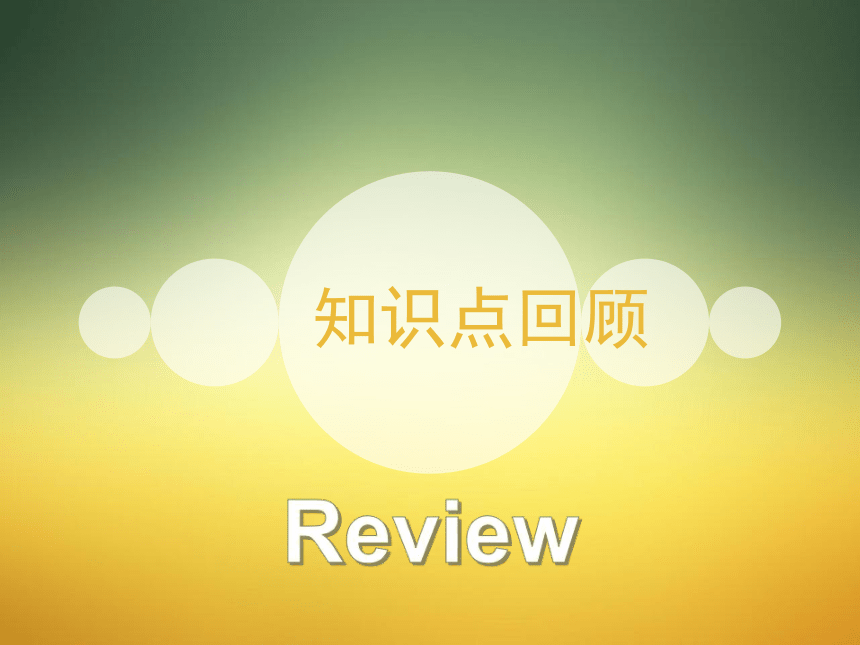 | |
| 格式 | zip | ||
| 文件大小 | 978.2KB | ||
| 资源类型 | 教案 | ||
| 版本资源 | 通用版 | ||
| 科目 | 英语 | ||
| 更新时间 | 2022-05-30 15:18:30 | ||
图片预览

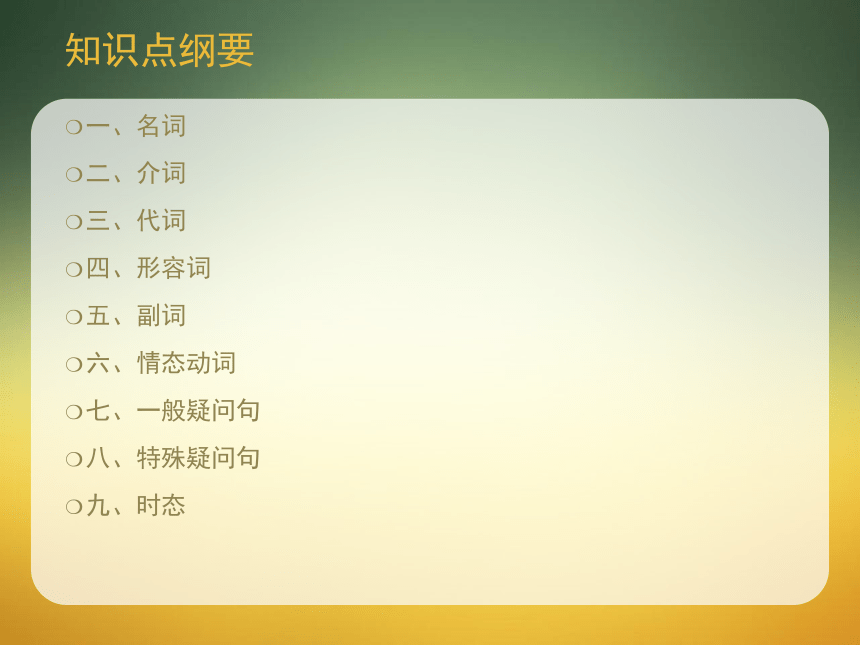
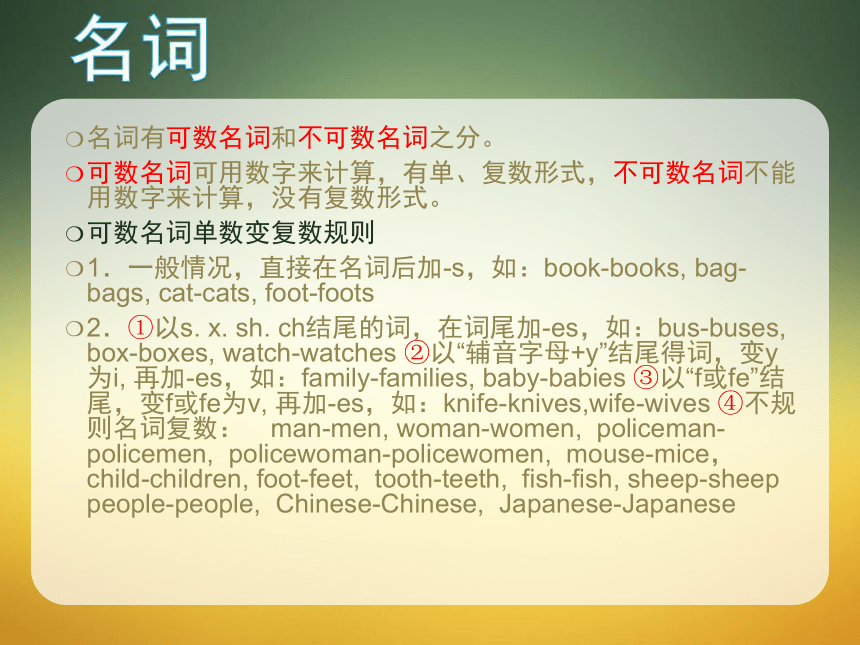
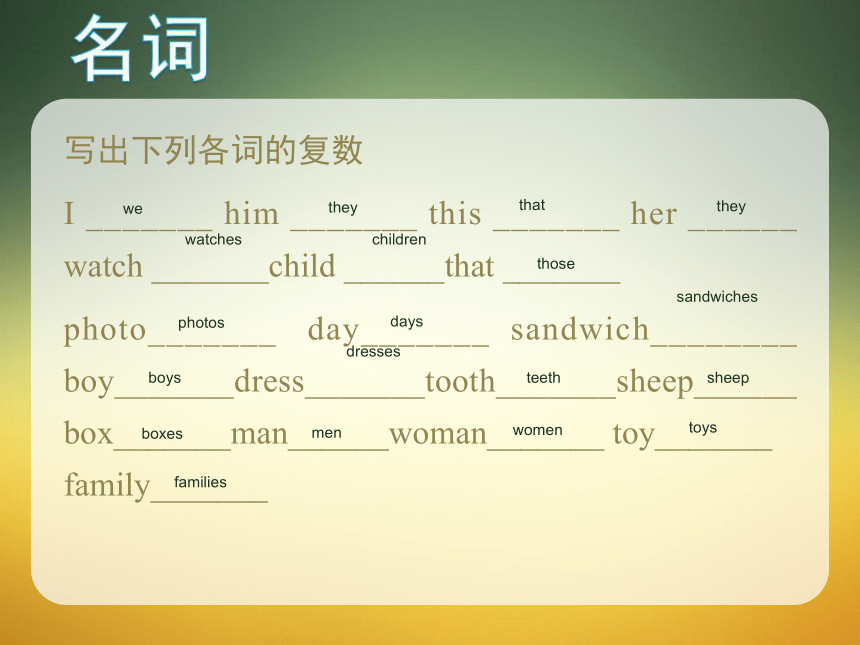
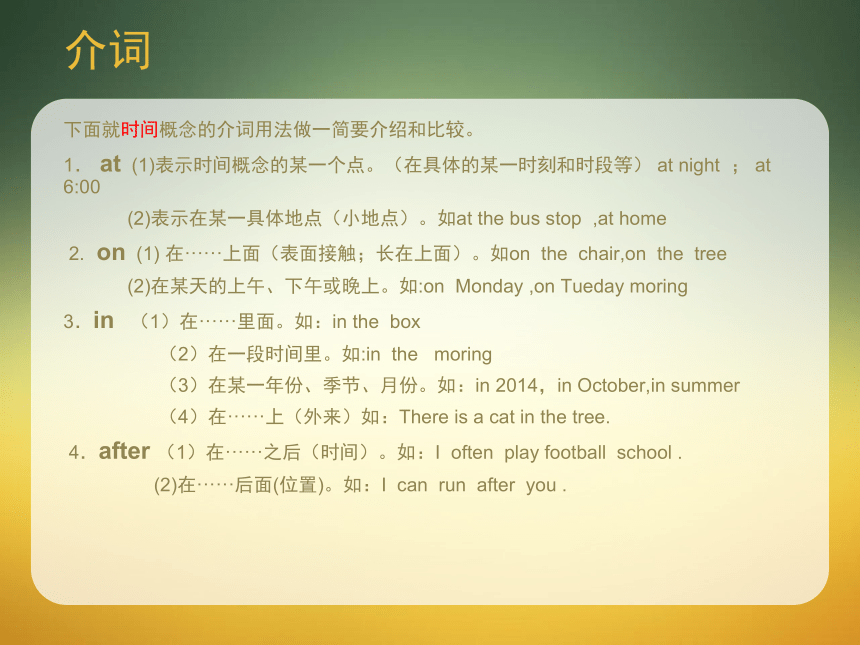
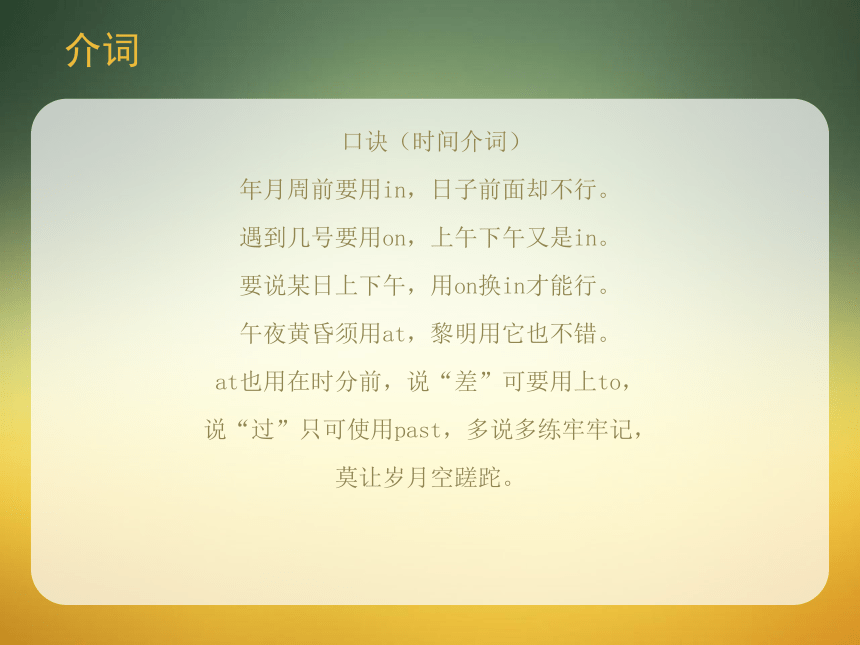
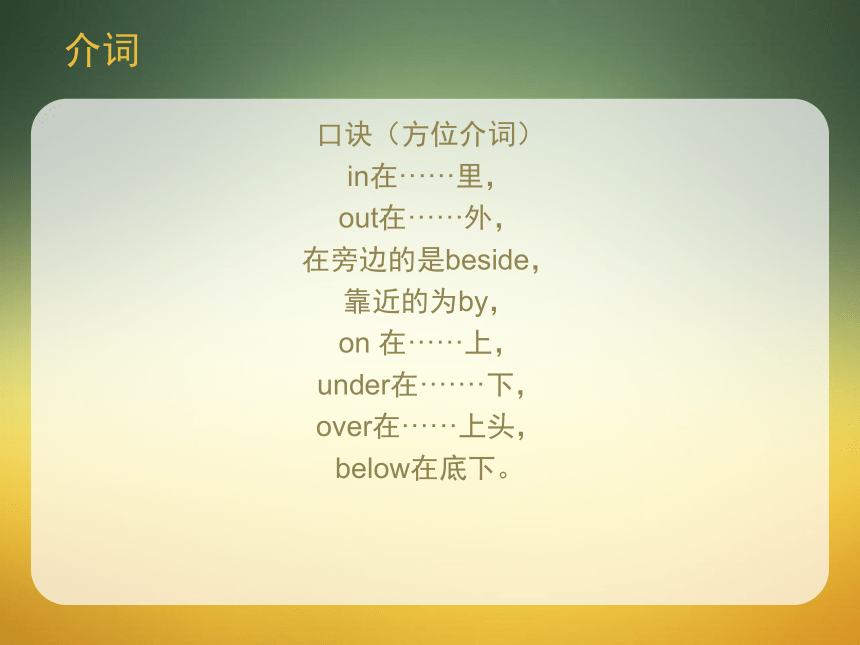
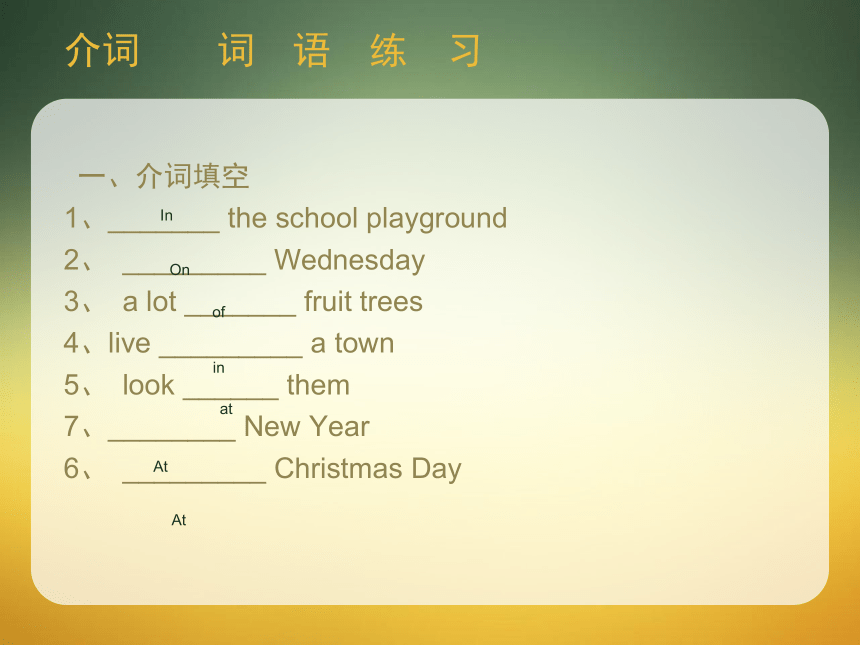
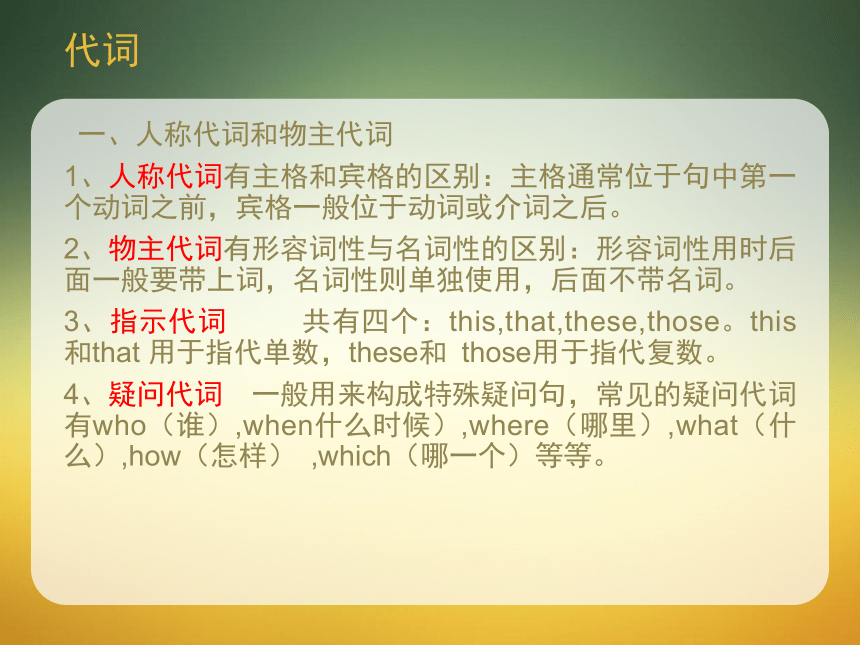
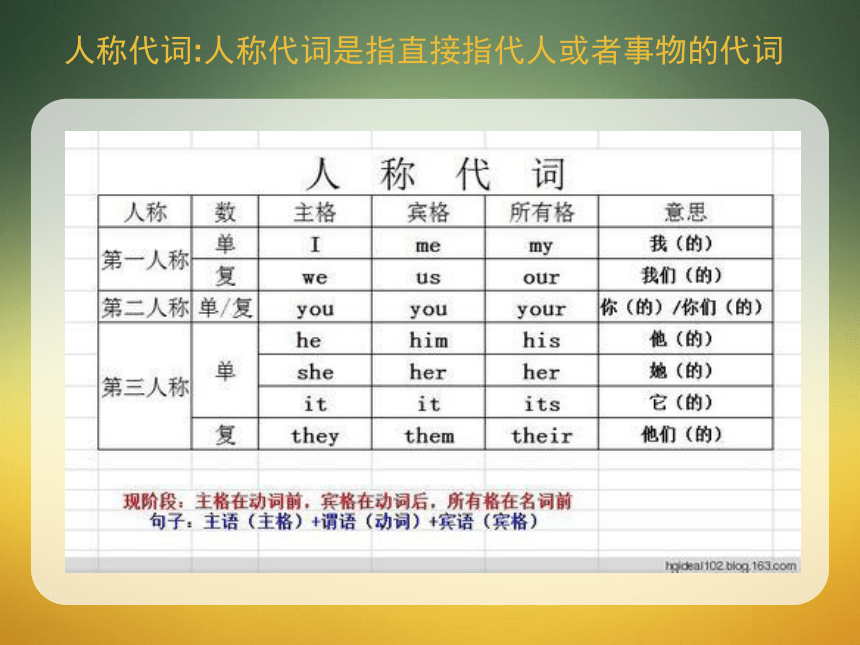
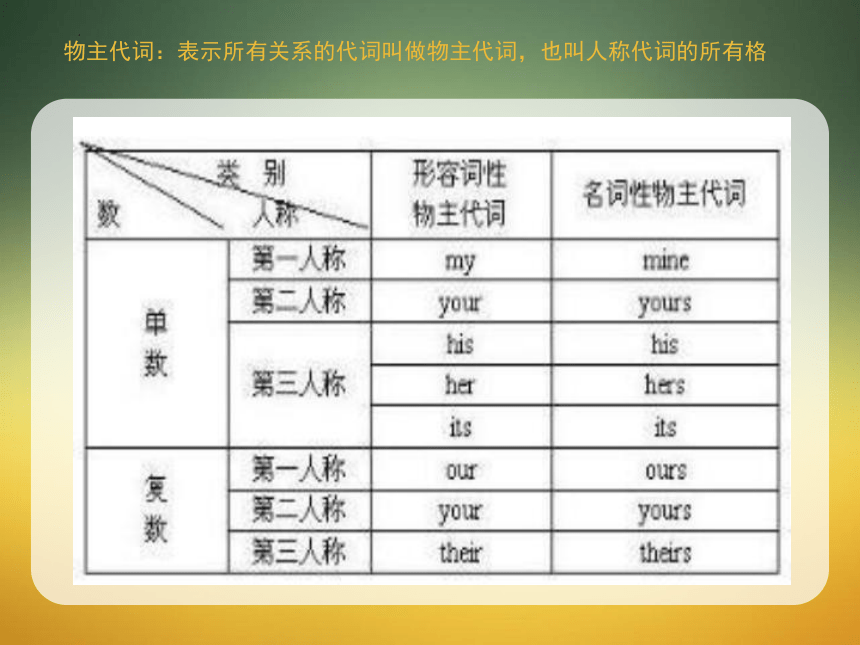
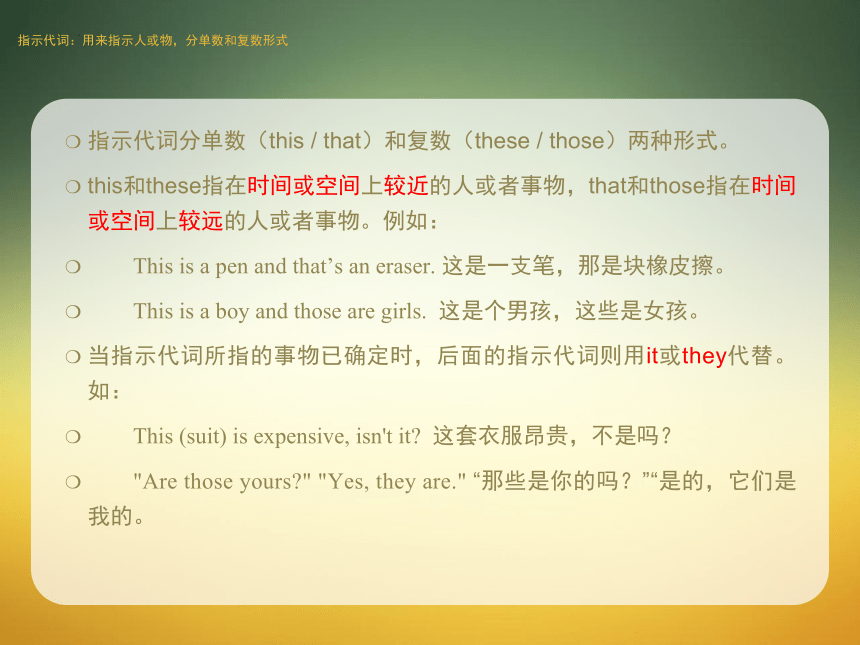
文档简介
(共64张PPT)
知识点回顾
知识点纲要
一、名词
二、介词
三、代词
四、形容词
五、副词
六、情态动词
七、一般疑问句
八、特殊疑问句
九、时态
名词有可数名词和不可数名词之分。
可数名词可用数字来计算,有单、复数形式,不可数名词不能用数字来计算,没有复数形式。
可数名词单数变复数规则
1.一般情况,直接在名词后加-s,如:book-books, bag-bags, cat-cats, foot-foots
2.①以s. x. sh. ch结尾的词,在词尾加-es,如:bus-buses, box-boxes, watch-watches ②以“辅音字母+y”结尾得词,变y为i, 再加-es,如:family-families, baby-babies ③以“f或fe”结尾,变f或fe为v, 再加-es,如:knife-knives,wife-wives ④不规则名词复数: man-men, woman-women, policeman-policemen, policewoman-policewomen, mouse-mice,child-children, foot-feet, tooth-teeth, fish-fish, sheep-sheep people-people, Chinese-Chinese, Japanese-Japanese
写出下列各词的复数
I _______ him _______ this _______ her ______ watch _______child ______that _______
photo_______ day_______ sandwich________ boy_______dress_______tooth_______sheep______ box_______man______woman_______ toy_______ family_______
we
they
that
they
watches
children
those
photos
days
sandwiches
boys
dresses
teeth
sheep
boxes
men
women
toys
families
介词
下面就时间概念的介词用法做一简要介绍和比较。
1. at (1)表示时间概念的某一个点。(在具体的某一时刻和时段等) at night ; at 6:00
(2)表示在某一具体地点(小地点)。如at the bus stop ,at home
2. on (1) 在······上面(表面接触;长在上面)。如on the chair,on the tree
(2)在某天的上午、下午或晚上。如:on Monday ,on Tueday moring
3.in (1)在······里面。如:in the box
(2)在一段时间里。如:in the moring
(3)在某一年份、季节、月份。如:in 2014,in October,in summer
(4)在······上(外来)如:There is a cat in the tree.
4.after (1)在······之后(时间)。如:I often play football school .
(2)在······后面(位置)。如:I can run after you .
口诀(时间介词)
年月周前要用in,日子前面却不行。
遇到几号要用on,上午下午又是in。
要说某日上下午,用on换in才能行。
午夜黄昏须用at,黎明用它也不错。
at也用在时分前,说“差”可要用上to,
说“过”只可使用past,多说多练牢牢记,
莫让岁月空蹉跎。
介词
口诀(方位介词)
in在······里,
out在······外,
在旁边的是beside,
靠近的为by,
on 在······上,
under在·······下,
over在······上头,
below在底下。
介词
一、介词填空
1、_______ the school playground
2、 _________ Wednesday
3、 a lot _______ fruit trees
4、live _________ a town
5、 look ______ them
7、________ New Year
6、 _________ Christmas Day
介词 词 语 练 习
In
On
of
in
at
At
At
一、人称代词和物主代词
1、人称代词有主格和宾格的区别:主格通常位于句中第一个动词之前,宾格一般位于动词或介词之后。
2、物主代词有形容词性与名词性的区别:形容词性用时后面一般要带上词,名词性则单独使用,后面不带名词。
3、指示代词 共有四个:this,that,these,those。this 和that 用于指代单数,these和 those用于指代复数。
4、疑问代词 一般用来构成特殊疑问句,常见的疑问代词有who(谁),when什么时候),where(哪里),what(什么),how(怎样) ,which(哪一个)等等。
代词
人称代词:人称代词是指直接指代人或者事物的代词
物主代词:表示所有关系的代词叫做物主代词,也叫人称代词的所有格
指示代词分单数(this / that)和复数(these / those)两种形式。
this和these指在时间或空间上较近的人或者事物,that和those指在时间或空间上较远的人或者事物。例如:
This is a pen and that’s an eraser. 这是一支笔,那是块橡皮擦。
This is a boy and those are girls. 这是个男孩,这些是女孩。
当指示代词所指的事物已确定时,后面的指示代词则用it或they代替。如:
This (suit) is expensive, isn't it 这套衣服昂贵,不是吗?
"Are those yours " "Yes, they are." “那些是你的吗?”“是的,它们是我的。
指示代词:用来指示人或物,分单数和复数形式
常见的疑问代词有who(谁)when(什么时候),where(哪里),what(什么),how(怎样) ,which(哪一个)等等。
疑问代词:一般用来构成特殊疑问句
用所给词的适当形式填空
1. That is not _________ kite. That kite is very small, but _________ is very big. ( I )
2. The dress is _________. Give it to _________. ( she )
3. Is this _________ watch (you) No, it's not _________ . ( I )
4. _________ is my brother. _________ name is Jack. Look! Those stamps are _________. ( he )
5. _________ dresses are red. (we) What colour are _________ ( you )
6. Here are many dolls, which one is _________ ( she )
7. I have a beautiful cat. _________name is Mimi. These cakes are _________. ( it )
练习
my
mine
hers
her
your
mine
He
His
his
Our
yours
hers
Its
its
8. Are these _________ tickets No, _________ are not _________. _________ aren’t here. ( they )
9. I have a lovely brother. _________ is only 3. I like _________ very much. ( he )
10. _________ is my aunt. Do you know _________ job _________ a nurse. ( she )
11. So many dogs. Let’s count _________. ( they )
三、用am, is, are 填空
1. I ______ a boy. ______ you a boy No, I _____ not.
练习
their
theirs
them
Theirs
He
him
She
her
She
them
am
Are
am
2. The girl______ Jack's sister.
3. The dog _______ tall and fat.
4. The man with big eyes _______ a teacher.
5. You, he and I ______ from China.
6. Where _____ your mother She ______ at home.
7. Mike and Liu Tao ______ at school.
8. Whose dress ______ this
9. Whose socks ______ they
10. That ______ my red skirt.
is
is
is
are
is
is
are
is
are
is
形容词:用于修饰名词,通常置于名词前
不规则变化的形容词:
little / few(原形) - less (比较级)- least(最高级)
good(原形) - better(比较级) - best(最高级)
bad (原形) - worse(比较级) - worst(最高级 )
情态动词无人称和数的变化,情态动词后面跟的动词须用原形,否定式构成是在情态动词后面加 "not"。个别情态动词有现在式和 过去式两种形式,过去式用来表达更加客气, 委婉的语气,时态性不强,可用于 过去, 现在或 将来。
情态动词数量不多,但用途广泛,主要有下列:
can (could),may (might),must,need,shall (should),
will (would)
情态动词:情态动词用在行为动词前,表示说话人对这一动作或状态的 看法或主观设想
其结构是:
系动词be/助动词/情态动词+主语+其他成分
通常回答为:
肯定:Yes,主语+提问的系动词be/助动词/情态动词.
否定:No,主语+提问的系动词be/助动词/情态动词的否定形式.
例如:Is he a teacher
肯定回答:Yes,he is.
否定回答:No,he is not(isn't).
一般疑问句:是疑问句的一种。它是只用yes(是)或no(否)来回答的句子。
Be动词
特殊疑问句:以特殊疑问词开头,对句中某一成分提问的句子
What (问什么事,什么物或什么工作) What are you doing?What did you do yesterday What are you going to do I’m reading.I played basketball.I’m going to do homework.
What is that It’s a book.
What is she (What’s her job ) She’s a nurse.
What colour(问颜色) What colour is your coat It’s red.
What time(时间) What time is it What’s the time It’s seven.
when(什么时候) When do you get up I get up at six thirty.
When is your birthday It’s on the 21st of December.
Which(哪一个) Which is your watch, the yellow one or the white one The yellow is mine.
Who(谁) Who is the man with a big nose He’s my uncle.
Whose(谁的) Whose bag is it Whose is this bag It’s his bag.
Where(哪里) Where is my ball pen It’s under the book.
Why(为什么) Why do you like summer Because…
How many (多少) How many books are there in the school bag There are four books in the school bag.
How old (几岁) How old is the young man He’s nineteen.
How much(多少钱) How much is the toy bear It’s eleven yuan.
How (怎么样) How do you go to school everyday I go to school by car.
How long/ big/tall How long is the river It’s 10 miles long.
时
态
时态:是一种动词形式,不同的时态用以表示不同的时间与方式。它是表示行为、动作、状态在各种时间条件下的动词形式
一般现在时
一般将来时
一般现在进行时
一般过去时
1.表示经常的或习惯性的动作,常与表示频率的时间状语连用,(alway, usually, sometime, never, every day, every week,······ 如:I get up at six every day.我每天六点起床。
2.表示客观现实和普遍的真理。如:The earth moves around the sun.地球绕着太阳转。
3.表示主语的特征、能力、职业、性格。 如:The sky is blue.天空是蓝色的。My mother is a teacher .我妈妈是位老师。
一般现在时基本用法:
1. be动词:
①肯定句:主语+be(am, is, are)+其它。
如: I am a boy. 我是一个男孩。
②否定句:主语+ be + not +其它。
如:He is not a worker.他不是工人。
③一般疑问句:Be +主语+其它。
如:-Are you a student -Yes. I am. / No, I'm not.
一般现在时的构成:
2. 行为动词:
①肯定句:主语+行为动词(+其它)。
如: We study English. 我们学习英语。 (当主语为第三人称单数(he, she, it)时,要在动词后加"-s"或"-es"。如:Mary likes Chinese.玛丽喜欢汉语)
②否定句:主语+ don't( doesn't ) +动词原形(+其它)。 如: I don't like bread. (当主语为第三人称单数时,要用doesn't构成否定句。如: He doesn't often play.)
③一般疑问句:Do( Does ) +主语+动词原形+其它。如:- Do you often play football - Yes, I do. / No, I don't.。
一般现在时的构成:
(三)一般现在时动词第三人称单数形式变化规则:
1.一般情况下,直接加-s,如:look-looks, play--plays
2.以s. x. sh. ch. o结尾,加-es,如: wash-washes, watch-watches, go-goes
3.以“辅音字母+y”结尾,变y为i, 再加-es,如:study-studies,fly--flies
另外,还有一些特殊情况,需熟记。如:have—has
一般现在时
一般现在时用法练习:
一、 写出下列动词的第三人称单数
drink______ go_______ stay ________
make ________look ________ have_______ pass_______ carry__________
come________ watch______ fly ________ study_______ do_________ teach_______ have_______
练习
drinks
goes
stays
makes
looks
has
passes
carries
comes
watches
flies
studies
does
teaches
has
二、用括号内动词的适当形式填空。
1. He often ________(have) dinner at home.
2. Daniel and Tommy _______(be) in Class One.
3. We _______ (not watch) TV on Monday.
4. Nick _______ (not go) to the zoo on Sunday.
6. What _______they often _______(do) on Saturdays
7. She _______(go) to school from Monday to Friday.
8. The girl _______(teach) us English on Sundays.
练习
has
are
don't watch
doesn't go
do
do
goes
teaches
9. She and I ________(take) a walk together every evening.
10. There ________(be) some water in the bottle.
11. Mike _______(like) cooking.
12. They _______(have) the same hobby.
13. My aunt _______(look) after her baby carefully.
14. You always _______(do) your homework well.
15. What day _______(be) it today - It's Saturday.
16. The child often _______(watch) TV in the evening.
练习
take
likes
have
is
looks
do
is
waches
现在进行时由主语+be+动词ing构成
-现在进行时:表示现在正在进行或发生的动作
①肯定句 基本结构:主语+be+ 动词ing.
如: I am watching TV.
②否定句 基本结构:主语+be not + 动词ing.
如: I am not watching TV.
③一般疑问句 基本结构: be动词 +主语 +动词ing
如: Are you watching TV
Yes , I am./No,I am not.
④特殊疑问句 基本结构:疑问词+ be +主语+动词ing 如:What are you doing
但疑问词当主语时,其结构为:疑问词+ be + 动词ing 如:Who is watching TV
动词加ing(动词现在分词)的变化规则 即动词现在分词构成:动词原形+ing,规则如下:
① 一般情况下直接加ing think---thinking sleep---sleeping send---sending speak---speaking
②以不发音的字母e结尾的单词,去掉字母e,再加ing come---coming make---making leave---leaving have---having take---taking
③ 以重读闭音节(重读闭音节即两个辅音中间夹一个元音并且重读的音节)结尾,先双写末尾的辅音字母,再加ing stop---stopping sit---sitting run---running skip---skipping 这类词还有:get, run, set, sit, stop, swim, drop 等。
现在进行时动词变化规则
一、写出下列动词的现在分词:
play________ run__________
swim _________make__________ stop_________ go_______teach_________ walk________ write________read________have_________shop_____sing ________ dance_________put_________ see________ buy _________ love____________ live_______ take_________ come ________ get_________
现在进行时专项练习
playing
running
swimming
making
stopping
going
teaching
walking
writing
reading
having
shopping
singing
dancing
putting
seeing
buying
loving
living
taking
coming
getting
1.The boy __________________ ( draw)a picture now.
2. Listen .Some girls _______________ ( sing)in the classroom .
3. My mother _________________ ( cook )some nice food now.
4. What _____ you ______ ( do ) now
5.Look.They _________( have) an English lesson . 6. .______Helen____________(wash )clothes Yes ,she is .
7.Look! The girls ________________(dance )in the classroom .
8.What is our grandma doing She _________(listen ) to music.
二、用所给的动词的正确形式填空:
is drawing
are singing
is cooking
are
doing
are having
Is
washing
are dancing
is listening
1.They are doing housework.(改为否定句和一般疑问句)
2. The students are cleaning the classroom. (改为一般疑问句,并做肯定回答。)
3. I'm playing the football in the playground.(对划线部分进行提问。)
三、句型转换:
They aren't (are not) doing housework.
Are they doing housework
Are the students cleaning the classroom
Yes, they are.
What are you doing
常与一般将来时连用的时间状语有:tomorrow, next day(week, month, year…),soon, the day after tomorrow(后天)等。
一般将来时的用法和结构;
⑴肯定句: ①主语+will+ 动词原形+其它.
如:I will go to the park tomorrow.
②主语+be going to + 动词原形+其它
如:I am going to go to the park tomorrow.
I will go to the park tomorrow. = I am going to go to the park tomorrow.
⑵否定句:在be动词后加not,will后加not(will not=won’t)。
例如:I will have a picnic this afternoon.→ I won’t going to have a picnic this afternoon.
一般将来时 表示将来某个时间要发生的动作或存在的状态,也可以表示打算、计划或准备做某事。
be going to = will
⑶一般疑问句:把be或will提到句首,some改为any, and改为or,第一二人称互换。
如:I will go to the park tomorrow.-----Will you go to the park tomorrow
⑷ 特殊疑问句 1、问人疑问词为(Who)
例如:I’m going to New York soon. →Who’s going to New York soon
2. 问某人要去干什么疑问词为(What).
例如:My father is going to watch TV this afternoon. →What is your father going to do this afternoon
一般将来时
3. 问某人去哪里疑问词为(where)
例如: He’s going to have a picnic in the park.
Where is he going to have a picnic
4.问某人什么时候去疑问词为(when)
例如:She’s going to go to bed at nine.
When is she going to bed
一、填空
1. 我打算明天和朋友去野炊。
I have a picnic with my friends.
I have a picnic with my friends.
2. 下个星期一你打算去干嘛 我想去打篮球。
What next Monday
I play basketball.
What you do next Monday
I play basketball.
将来时练习:
am going to
will
are you going to do
am going to
will
will
3. 你妈妈这个周末去购物吗?是,她要去买一些水果。 _____ your mother _______ ________ go shopping this ___________
Yes, she ____. She ______ ________ __________ buy some fruit.
Is
going
to
weekend
is
is going to
二、按要求改写句子。
1.Nancy is going to dance.(改否定)
Nancy ________ going to dance.
2.I’ll go to school.(改否定)
I _______ go ______school.
3. I’m going to get up at 6:30 tomorrow.(改一般疑问句)
________ _______ ________ to get up at 6:30 tomorrow
is not
won't
to
Are you going
4.We will meet at the bus stop at 10:30.(改一般疑问句)
5.She is going to listen to music after school.(对划线部分提问)
Will we meet at the bus stop at 10:30
What is she going to do after school
三、用所给词的适当形式填空。
1. Today is a sunny day. We ________ (have) a picnic this afternoon.
12. My brother ___________(go) to Shanghai next week.
3. Tom often ____(go) to school on foot. But today is rain. He ______________ (go) to school by bike.
4. It's Friday today. What __she ____ (do) this weekend
5. Mary ______ (visit) her grandparents tomorrow.
6. Liu Tao ____ (fly) kites in the playground yesterday.
will have
is going to
goes
will go
is
going to do
will visit
flew
常用的表示过去的时间状语有:yesterday , last year /month/week/night, just now, ago.
一般过去时的句型结构;
⑴谓语动词为be动词的句型结构
① 肯定句:主语+be动词过去式+其它 如:Mr Li was a teacher ten years ago.
②否定句:主语+be动词过去式+not+其它 如: 如:Mr Li was not a teacher ten years ago.
③be动词过去式+主语+其它 如:Was Mr Li a teacher ten years ago
一般过去式 一般过去时表示过去某个时间发生的动作或存在的状态,也表示过去经常或反复发生的动作
⑵一般过去时be动词的变化:
①am和is在一般过去时中变为was。
(was not=wasn’t)
②are在一般过去时中变为were。
(were not=weren’t)
③带有was或were的句子,其否定、疑问的变化和is, am, are一样,即否定句在was或were后加not,一般疑问句把was或were调到句首。
⑵谓语动词是实义动词的句型结构
①肯定句:主语+动词过去式+其它 如: Jim went home yesterday.
②否定句:主语+didn’t +动词原形? 如:Jim didn’t go home yesterday.
③一般疑问句: Did+主语+动词原形? 如:Did Jim go home yesterday
④ 特殊疑问句:疑问词+did+主语+动词原形? 如: What did Jim do yesterday 当疑问词做主语时:疑问词+动词过去式?如:Who went home yesterday
1.一般在动词末尾加-ed,
如:play—played, cook-cooked
2.结尾是e加d,如:like—liked
3.以重读闭音节结尾,先双写末尾的辅音字母,在加-ed,如:stop-stopped
4.以“辅音字母+y”结尾的,变y为i, 再加-ed,如:study-studied
5.不规则动词过去式: am, is-was, are-were, do-did, see-saw, say-said, give-gave, get-got, go-went, come-came, have-had, eat-ate, take-took, run-ran, sing-sang, put-put, make-made, read-read, write-wrote, draw-drew, drink-drank, fly-flew, ride-rode, speak-spoke, sweep-swept, swim-swam, sit-sat
动词过去式变化规则:
一、写出下列动词的过去式
is\am_________ fly_______eat________ are ________ look_________ drink_________ play_______ go________ make ________ buy_______ does_________ dance________ worry________
ask _____ see_________ watch_________ win__________ do ________ put ______ give_____
过去时练习
was
flew
ate
were
looked
drunk
played
went
made
bought
did
danced
worried
asked
saw
watched
won
did
put
gave
二、用be动词的适当形式填空
1. I _______ at school just now.
2. He ________ at the camp last week.
3. We ________ students two years ago.
4. They ________ on the farm a moment ago.
5. Yang Ling ________ eleven years old last year.
6. There ________ an apple on the plate yesterday.
was
was
were
were
was
was
1.He was an English teacher.
否定句:
一般疑问句:
肯定/否定回答:
2.All the students are very happy.
否定句:
一般疑问句:
肯定/否定回答:
句型转换
He was not an English teacher.
Was he an English teacher
Yes,he was./No, he wasn't.
All the students are not very happy.
Are all the students very happy
Yes,they are./No,they are not.
一、用行为动词的适当形式填空
1. He _________ (live) in Wuxi two years ago.
2. The cat ________ (eat) a bird last night.
3. We _______ (have) a party last Halloween.
4. Nancy ________ (pick) up oranges on the farm last week.
5. I ________ (make) a model ship with Mike yesterday.
6. They ________ (play) chess in the classroom last PE lesson.
过去时练习
lived
ate
had
picked
made
played
7. My mother _______ (cook) a nice food last Spring Festival.
8. The girls ________ (sing) and _______ (dance) at the party.
二、句型转换
1. Su Hai took some photos at the Sports day.
否定句:
一般疑问句:
肯定/否定回答:
cooked
sang
danced
Su Hai didn't take some photos at the Sports day.
Did Su Hai take some photos at the Sports day
Yes,he did./ No,he didn't.
2. Nancy went to school early.
否定句:
一般疑问句:
肯定/否定回答:
3. We sang some English songs.
否定句:
一般疑问句:
肯定/否定回答:
Nancy didn't go to school early.
Did Nancy go to school early
Yes, she did./ No, she didn't.
We didn't sing some English songs.
Did you sing some English songs
Yes,we did./ No, we didn't.
There be 句型与have, has的区别
1、There be 句型表示:在某地有某物(或人)
2、在there be 句型中,主语是单数,be 动词用is 主语是复数,be 动词用are。如有几件物品,be 动词根据最近be 动词的那个名词决定。
3、there be 句型的否定句在be 动词后加not , 一般疑问句把be 动词调到句首。
4、there be句型与have(has) 的区别:there be 表示在某地有某物(或人);have(has) 表示某人拥有某物。
其他
5、some 和any 在there be 句型中的运用:some 用于肯定句, any 用于否定句或疑问句。
6、and 和or 在there be句型中的运用:and 用于肯定句, or 用于否定句或疑问句。
7、针对数量提问的特殊疑问句的基本结构是:
How many + 名词复数 + are there + 介词短语?
How much + 不可数名词 + is there + 介词短语?
a. an .the的用法
1.单词的第一读音是辅音读音:a book, a peach, a “U”
单词的第一个读音是元音读音:an egg,an hour, an “F”
2.the要注意的:球类前面不加the,play football
乐器前面要加the,play the piano
序数词前面要加the, the second
1. 直接在基数词词尾加上th。
如:seventh第七,tenth 第十,thirteenth 第十三,
2.以y结尾的基数词,变y为i,再加上eth。
如:twentieth 第二十。
3.不规则的。
如:first 第一, second 第二, third 第三,fifth 第五, eighth 第八,ninth 第九,twelfth 第十二。
4.有两个或以上单词组成的基数词只改最后一个单词
如:twenty-first 第二十一。
基数词变成序数词的方法
Fill in the blank with “have,has”or “there is , there are”
1. I________a good father and a good mother.
2. ____________a book on the desk.
3. He_________a stamp.
4. _____________a basketball in the playground.
5. She__________some dresses.
6. They___________a nice garden.
7. What do you___________
练习
have
There is
has
There is
has
have
have
8. ______________a reading-room in the building
9. What does Mike___________
10. ______________a map of the world on the wall.
11. My father_________a story-book.
12. _______________a story-book on the table.
13. _____________some maps on the wall.
14. How many students____________in the classroom
15. My parents___________some nice pictures.
Is there
have
There is
has
There is
There are
are there
have
1、There_______ a lot of sweets in the box.
2、There _______ some milk in the glass.
3、There _______ some people under the the big tree.
4、There _______ a picture and a map on the wall.
5、_______ there any kites in the classroom
6、There _______ lots of flowers in our garden last year.
7、There _______ four cups of coffee on the table.
8. There ______ a girl in the room.
用恰当的be动词填空。
are
is
are
is
Are
are
are
is
1. Miss Li__________an English book
2. He_________a good friend.
3. They__________ some masks.
4. We___________some flowers.
5. She___________ a duck.
6. My father____________ a new bike.
7. Our teacher_________ an English book.
Fill in the blank with “ have, has ”
has
has
have
have
has
has
has
8. Nancy_________many skirts.
9. David__________some jackets.
11. My friends__________a football.
12. What do you__________
14. What does Mike__________
15. His brother________a basketball.
has
has
have
have
have
has
知识点回顾
知识点纲要
一、名词
二、介词
三、代词
四、形容词
五、副词
六、情态动词
七、一般疑问句
八、特殊疑问句
九、时态
名词有可数名词和不可数名词之分。
可数名词可用数字来计算,有单、复数形式,不可数名词不能用数字来计算,没有复数形式。
可数名词单数变复数规则
1.一般情况,直接在名词后加-s,如:book-books, bag-bags, cat-cats, foot-foots
2.①以s. x. sh. ch结尾的词,在词尾加-es,如:bus-buses, box-boxes, watch-watches ②以“辅音字母+y”结尾得词,变y为i, 再加-es,如:family-families, baby-babies ③以“f或fe”结尾,变f或fe为v, 再加-es,如:knife-knives,wife-wives ④不规则名词复数: man-men, woman-women, policeman-policemen, policewoman-policewomen, mouse-mice,child-children, foot-feet, tooth-teeth, fish-fish, sheep-sheep people-people, Chinese-Chinese, Japanese-Japanese
写出下列各词的复数
I _______ him _______ this _______ her ______ watch _______child ______that _______
photo_______ day_______ sandwich________ boy_______dress_______tooth_______sheep______ box_______man______woman_______ toy_______ family_______
we
they
that
they
watches
children
those
photos
days
sandwiches
boys
dresses
teeth
sheep
boxes
men
women
toys
families
介词
下面就时间概念的介词用法做一简要介绍和比较。
1. at (1)表示时间概念的某一个点。(在具体的某一时刻和时段等) at night ; at 6:00
(2)表示在某一具体地点(小地点)。如at the bus stop ,at home
2. on (1) 在······上面(表面接触;长在上面)。如on the chair,on the tree
(2)在某天的上午、下午或晚上。如:on Monday ,on Tueday moring
3.in (1)在······里面。如:in the box
(2)在一段时间里。如:in the moring
(3)在某一年份、季节、月份。如:in 2014,in October,in summer
(4)在······上(外来)如:There is a cat in the tree.
4.after (1)在······之后(时间)。如:I often play football school .
(2)在······后面(位置)。如:I can run after you .
口诀(时间介词)
年月周前要用in,日子前面却不行。
遇到几号要用on,上午下午又是in。
要说某日上下午,用on换in才能行。
午夜黄昏须用at,黎明用它也不错。
at也用在时分前,说“差”可要用上to,
说“过”只可使用past,多说多练牢牢记,
莫让岁月空蹉跎。
介词
口诀(方位介词)
in在······里,
out在······外,
在旁边的是beside,
靠近的为by,
on 在······上,
under在·······下,
over在······上头,
below在底下。
介词
一、介词填空
1、_______ the school playground
2、 _________ Wednesday
3、 a lot _______ fruit trees
4、live _________ a town
5、 look ______ them
7、________ New Year
6、 _________ Christmas Day
介词 词 语 练 习
In
On
of
in
at
At
At
一、人称代词和物主代词
1、人称代词有主格和宾格的区别:主格通常位于句中第一个动词之前,宾格一般位于动词或介词之后。
2、物主代词有形容词性与名词性的区别:形容词性用时后面一般要带上词,名词性则单独使用,后面不带名词。
3、指示代词 共有四个:this,that,these,those。this 和that 用于指代单数,these和 those用于指代复数。
4、疑问代词 一般用来构成特殊疑问句,常见的疑问代词有who(谁),when什么时候),where(哪里),what(什么),how(怎样) ,which(哪一个)等等。
代词
人称代词:人称代词是指直接指代人或者事物的代词
物主代词:表示所有关系的代词叫做物主代词,也叫人称代词的所有格
指示代词分单数(this / that)和复数(these / those)两种形式。
this和these指在时间或空间上较近的人或者事物,that和those指在时间或空间上较远的人或者事物。例如:
This is a pen and that’s an eraser. 这是一支笔,那是块橡皮擦。
This is a boy and those are girls. 这是个男孩,这些是女孩。
当指示代词所指的事物已确定时,后面的指示代词则用it或they代替。如:
This (suit) is expensive, isn't it 这套衣服昂贵,不是吗?
"Are those yours " "Yes, they are." “那些是你的吗?”“是的,它们是我的。
指示代词:用来指示人或物,分单数和复数形式
常见的疑问代词有who(谁)when(什么时候),where(哪里),what(什么),how(怎样) ,which(哪一个)等等。
疑问代词:一般用来构成特殊疑问句
用所给词的适当形式填空
1. That is not _________ kite. That kite is very small, but _________ is very big. ( I )
2. The dress is _________. Give it to _________. ( she )
3. Is this _________ watch (you) No, it's not _________ . ( I )
4. _________ is my brother. _________ name is Jack. Look! Those stamps are _________. ( he )
5. _________ dresses are red. (we) What colour are _________ ( you )
6. Here are many dolls, which one is _________ ( she )
7. I have a beautiful cat. _________name is Mimi. These cakes are _________. ( it )
练习
my
mine
hers
her
your
mine
He
His
his
Our
yours
hers
Its
its
8. Are these _________ tickets No, _________ are not _________. _________ aren’t here. ( they )
9. I have a lovely brother. _________ is only 3. I like _________ very much. ( he )
10. _________ is my aunt. Do you know _________ job _________ a nurse. ( she )
11. So many dogs. Let’s count _________. ( they )
三、用am, is, are 填空
1. I ______ a boy. ______ you a boy No, I _____ not.
练习
their
theirs
them
Theirs
He
him
She
her
She
them
am
Are
am
2. The girl______ Jack's sister.
3. The dog _______ tall and fat.
4. The man with big eyes _______ a teacher.
5. You, he and I ______ from China.
6. Where _____ your mother She ______ at home.
7. Mike and Liu Tao ______ at school.
8. Whose dress ______ this
9. Whose socks ______ they
10. That ______ my red skirt.
is
is
is
are
is
is
are
is
are
is
形容词:用于修饰名词,通常置于名词前
不规则变化的形容词:
little / few(原形) - less (比较级)- least(最高级)
good(原形) - better(比较级) - best(最高级)
bad (原形) - worse(比较级) - worst(最高级 )
情态动词无人称和数的变化,情态动词后面跟的动词须用原形,否定式构成是在情态动词后面加 "not"。个别情态动词有现在式和 过去式两种形式,过去式用来表达更加客气, 委婉的语气,时态性不强,可用于 过去, 现在或 将来。
情态动词数量不多,但用途广泛,主要有下列:
can (could),may (might),must,need,shall (should),
will (would)
情态动词:情态动词用在行为动词前,表示说话人对这一动作或状态的 看法或主观设想
其结构是:
系动词be/助动词/情态动词+主语+其他成分
通常回答为:
肯定:Yes,主语+提问的系动词be/助动词/情态动词.
否定:No,主语+提问的系动词be/助动词/情态动词的否定形式.
例如:Is he a teacher
肯定回答:Yes,he is.
否定回答:No,he is not(isn't).
一般疑问句:是疑问句的一种。它是只用yes(是)或no(否)来回答的句子。
Be动词
特殊疑问句:以特殊疑问词开头,对句中某一成分提问的句子
What (问什么事,什么物或什么工作) What are you doing?What did you do yesterday What are you going to do I’m reading.I played basketball.I’m going to do homework.
What is that It’s a book.
What is she (What’s her job ) She’s a nurse.
What colour(问颜色) What colour is your coat It’s red.
What time(时间) What time is it What’s the time It’s seven.
when(什么时候) When do you get up I get up at six thirty.
When is your birthday It’s on the 21st of December.
Which(哪一个) Which is your watch, the yellow one or the white one The yellow is mine.
Who(谁) Who is the man with a big nose He’s my uncle.
Whose(谁的) Whose bag is it Whose is this bag It’s his bag.
Where(哪里) Where is my ball pen It’s under the book.
Why(为什么) Why do you like summer Because…
How many (多少) How many books are there in the school bag There are four books in the school bag.
How old (几岁) How old is the young man He’s nineteen.
How much(多少钱) How much is the toy bear It’s eleven yuan.
How (怎么样) How do you go to school everyday I go to school by car.
How long/ big/tall How long is the river It’s 10 miles long.
时
态
时态:是一种动词形式,不同的时态用以表示不同的时间与方式。它是表示行为、动作、状态在各种时间条件下的动词形式
一般现在时
一般将来时
一般现在进行时
一般过去时
1.表示经常的或习惯性的动作,常与表示频率的时间状语连用,(alway, usually, sometime, never, every day, every week,······ 如:I get up at six every day.我每天六点起床。
2.表示客观现实和普遍的真理。如:The earth moves around the sun.地球绕着太阳转。
3.表示主语的特征、能力、职业、性格。 如:The sky is blue.天空是蓝色的。My mother is a teacher .我妈妈是位老师。
一般现在时基本用法:
1. be动词:
①肯定句:主语+be(am, is, are)+其它。
如: I am a boy. 我是一个男孩。
②否定句:主语+ be + not +其它。
如:He is not a worker.他不是工人。
③一般疑问句:Be +主语+其它。
如:-Are you a student -Yes. I am. / No, I'm not.
一般现在时的构成:
2. 行为动词:
①肯定句:主语+行为动词(+其它)。
如: We study English. 我们学习英语。 (当主语为第三人称单数(he, she, it)时,要在动词后加"-s"或"-es"。如:Mary likes Chinese.玛丽喜欢汉语)
②否定句:主语+ don't( doesn't ) +动词原形(+其它)。 如: I don't like bread. (当主语为第三人称单数时,要用doesn't构成否定句。如: He doesn't often play.)
③一般疑问句:Do( Does ) +主语+动词原形+其它。如:- Do you often play football - Yes, I do. / No, I don't.。
一般现在时的构成:
(三)一般现在时动词第三人称单数形式变化规则:
1.一般情况下,直接加-s,如:look-looks, play--plays
2.以s. x. sh. ch. o结尾,加-es,如: wash-washes, watch-watches, go-goes
3.以“辅音字母+y”结尾,变y为i, 再加-es,如:study-studies,fly--flies
另外,还有一些特殊情况,需熟记。如:have—has
一般现在时
一般现在时用法练习:
一、 写出下列动词的第三人称单数
drink______ go_______ stay ________
make ________look ________ have_______ pass_______ carry__________
come________ watch______ fly ________ study_______ do_________ teach_______ have_______
练习
drinks
goes
stays
makes
looks
has
passes
carries
comes
watches
flies
studies
does
teaches
has
二、用括号内动词的适当形式填空。
1. He often ________(have) dinner at home.
2. Daniel and Tommy _______(be) in Class One.
3. We _______ (not watch) TV on Monday.
4. Nick _______ (not go) to the zoo on Sunday.
6. What _______they often _______(do) on Saturdays
7. She _______(go) to school from Monday to Friday.
8. The girl _______(teach) us English on Sundays.
练习
has
are
don't watch
doesn't go
do
do
goes
teaches
9. She and I ________(take) a walk together every evening.
10. There ________(be) some water in the bottle.
11. Mike _______(like) cooking.
12. They _______(have) the same hobby.
13. My aunt _______(look) after her baby carefully.
14. You always _______(do) your homework well.
15. What day _______(be) it today - It's Saturday.
16. The child often _______(watch) TV in the evening.
练习
take
likes
have
is
looks
do
is
waches
现在进行时由主语+be+动词ing构成
-现在进行时:表示现在正在进行或发生的动作
①肯定句 基本结构:主语+be+ 动词ing.
如: I am watching TV.
②否定句 基本结构:主语+be not + 动词ing.
如: I am not watching TV.
③一般疑问句 基本结构: be动词 +主语 +动词ing
如: Are you watching TV
Yes , I am./No,I am not.
④特殊疑问句 基本结构:疑问词+ be +主语+动词ing 如:What are you doing
但疑问词当主语时,其结构为:疑问词+ be + 动词ing 如:Who is watching TV
动词加ing(动词现在分词)的变化规则 即动词现在分词构成:动词原形+ing,规则如下:
① 一般情况下直接加ing think---thinking sleep---sleeping send---sending speak---speaking
②以不发音的字母e结尾的单词,去掉字母e,再加ing come---coming make---making leave---leaving have---having take---taking
③ 以重读闭音节(重读闭音节即两个辅音中间夹一个元音并且重读的音节)结尾,先双写末尾的辅音字母,再加ing stop---stopping sit---sitting run---running skip---skipping 这类词还有:get, run, set, sit, stop, swim, drop 等。
现在进行时动词变化规则
一、写出下列动词的现在分词:
play________ run__________
swim _________make__________ stop_________ go_______teach_________ walk________ write________read________have_________shop_____sing ________ dance_________put_________ see________ buy _________ love____________ live_______ take_________ come ________ get_________
现在进行时专项练习
playing
running
swimming
making
stopping
going
teaching
walking
writing
reading
having
shopping
singing
dancing
putting
seeing
buying
loving
living
taking
coming
getting
1.The boy __________________ ( draw)a picture now.
2. Listen .Some girls _______________ ( sing)in the classroom .
3. My mother _________________ ( cook )some nice food now.
4. What _____ you ______ ( do ) now
5.Look.They _________( have) an English lesson . 6. .______Helen____________(wash )clothes Yes ,she is .
7.Look! The girls ________________(dance )in the classroom .
8.What is our grandma doing She _________(listen ) to music.
二、用所给的动词的正确形式填空:
is drawing
are singing
is cooking
are
doing
are having
Is
washing
are dancing
is listening
1.They are doing housework.(改为否定句和一般疑问句)
2. The students are cleaning the classroom. (改为一般疑问句,并做肯定回答。)
3. I'm playing the football in the playground.(对划线部分进行提问。)
三、句型转换:
They aren't (are not) doing housework.
Are they doing housework
Are the students cleaning the classroom
Yes, they are.
What are you doing
常与一般将来时连用的时间状语有:tomorrow, next day(week, month, year…),soon, the day after tomorrow(后天)等。
一般将来时的用法和结构;
⑴肯定句: ①主语+will+ 动词原形+其它.
如:I will go to the park tomorrow.
②主语+be going to + 动词原形+其它
如:I am going to go to the park tomorrow.
I will go to the park tomorrow. = I am going to go to the park tomorrow.
⑵否定句:在be动词后加not,will后加not(will not=won’t)。
例如:I will have a picnic this afternoon.→ I won’t going to have a picnic this afternoon.
一般将来时 表示将来某个时间要发生的动作或存在的状态,也可以表示打算、计划或准备做某事。
be going to = will
⑶一般疑问句:把be或will提到句首,some改为any, and改为or,第一二人称互换。
如:I will go to the park tomorrow.-----Will you go to the park tomorrow
⑷ 特殊疑问句 1、问人疑问词为(Who)
例如:I’m going to New York soon. →Who’s going to New York soon
2. 问某人要去干什么疑问词为(What).
例如:My father is going to watch TV this afternoon. →What is your father going to do this afternoon
一般将来时
3. 问某人去哪里疑问词为(where)
例如: He’s going to have a picnic in the park.
Where is he going to have a picnic
4.问某人什么时候去疑问词为(when)
例如:She’s going to go to bed at nine.
When is she going to bed
一、填空
1. 我打算明天和朋友去野炊。
I have a picnic with my friends.
I have a picnic with my friends.
2. 下个星期一你打算去干嘛 我想去打篮球。
What next Monday
I play basketball.
What you do next Monday
I play basketball.
将来时练习:
am going to
will
are you going to do
am going to
will
will
3. 你妈妈这个周末去购物吗?是,她要去买一些水果。 _____ your mother _______ ________ go shopping this ___________
Yes, she ____. She ______ ________ __________ buy some fruit.
Is
going
to
weekend
is
is going to
二、按要求改写句子。
1.Nancy is going to dance.(改否定)
Nancy ________ going to dance.
2.I’ll go to school.(改否定)
I _______ go ______school.
3. I’m going to get up at 6:30 tomorrow.(改一般疑问句)
________ _______ ________ to get up at 6:30 tomorrow
is not
won't
to
Are you going
4.We will meet at the bus stop at 10:30.(改一般疑问句)
5.She is going to listen to music after school.(对划线部分提问)
Will we meet at the bus stop at 10:30
What is she going to do after school
三、用所给词的适当形式填空。
1. Today is a sunny day. We ________ (have) a picnic this afternoon.
12. My brother ___________(go) to Shanghai next week.
3. Tom often ____(go) to school on foot. But today is rain. He ______________ (go) to school by bike.
4. It's Friday today. What __she ____ (do) this weekend
5. Mary ______ (visit) her grandparents tomorrow.
6. Liu Tao ____ (fly) kites in the playground yesterday.
will have
is going to
goes
will go
is
going to do
will visit
flew
常用的表示过去的时间状语有:yesterday , last year /month/week/night, just now, ago.
一般过去时的句型结构;
⑴谓语动词为be动词的句型结构
① 肯定句:主语+be动词过去式+其它 如:Mr Li was a teacher ten years ago.
②否定句:主语+be动词过去式+not+其它 如: 如:Mr Li was not a teacher ten years ago.
③be动词过去式+主语+其它 如:Was Mr Li a teacher ten years ago
一般过去式 一般过去时表示过去某个时间发生的动作或存在的状态,也表示过去经常或反复发生的动作
⑵一般过去时be动词的变化:
①am和is在一般过去时中变为was。
(was not=wasn’t)
②are在一般过去时中变为were。
(were not=weren’t)
③带有was或were的句子,其否定、疑问的变化和is, am, are一样,即否定句在was或were后加not,一般疑问句把was或were调到句首。
⑵谓语动词是实义动词的句型结构
①肯定句:主语+动词过去式+其它 如: Jim went home yesterday.
②否定句:主语+didn’t +动词原形? 如:Jim didn’t go home yesterday.
③一般疑问句: Did+主语+动词原形? 如:Did Jim go home yesterday
④ 特殊疑问句:疑问词+did+主语+动词原形? 如: What did Jim do yesterday 当疑问词做主语时:疑问词+动词过去式?如:Who went home yesterday
1.一般在动词末尾加-ed,
如:play—played, cook-cooked
2.结尾是e加d,如:like—liked
3.以重读闭音节结尾,先双写末尾的辅音字母,在加-ed,如:stop-stopped
4.以“辅音字母+y”结尾的,变y为i, 再加-ed,如:study-studied
5.不规则动词过去式: am, is-was, are-were, do-did, see-saw, say-said, give-gave, get-got, go-went, come-came, have-had, eat-ate, take-took, run-ran, sing-sang, put-put, make-made, read-read, write-wrote, draw-drew, drink-drank, fly-flew, ride-rode, speak-spoke, sweep-swept, swim-swam, sit-sat
动词过去式变化规则:
一、写出下列动词的过去式
is\am_________ fly_______eat________ are ________ look_________ drink_________ play_______ go________ make ________ buy_______ does_________ dance________ worry________
ask _____ see_________ watch_________ win__________ do ________ put ______ give_____
过去时练习
was
flew
ate
were
looked
drunk
played
went
made
bought
did
danced
worried
asked
saw
watched
won
did
put
gave
二、用be动词的适当形式填空
1. I _______ at school just now.
2. He ________ at the camp last week.
3. We ________ students two years ago.
4. They ________ on the farm a moment ago.
5. Yang Ling ________ eleven years old last year.
6. There ________ an apple on the plate yesterday.
was
was
were
were
was
was
1.He was an English teacher.
否定句:
一般疑问句:
肯定/否定回答:
2.All the students are very happy.
否定句:
一般疑问句:
肯定/否定回答:
句型转换
He was not an English teacher.
Was he an English teacher
Yes,he was./No, he wasn't.
All the students are not very happy.
Are all the students very happy
Yes,they are./No,they are not.
一、用行为动词的适当形式填空
1. He _________ (live) in Wuxi two years ago.
2. The cat ________ (eat) a bird last night.
3. We _______ (have) a party last Halloween.
4. Nancy ________ (pick) up oranges on the farm last week.
5. I ________ (make) a model ship with Mike yesterday.
6. They ________ (play) chess in the classroom last PE lesson.
过去时练习
lived
ate
had
picked
made
played
7. My mother _______ (cook) a nice food last Spring Festival.
8. The girls ________ (sing) and _______ (dance) at the party.
二、句型转换
1. Su Hai took some photos at the Sports day.
否定句:
一般疑问句:
肯定/否定回答:
cooked
sang
danced
Su Hai didn't take some photos at the Sports day.
Did Su Hai take some photos at the Sports day
Yes,he did./ No,he didn't.
2. Nancy went to school early.
否定句:
一般疑问句:
肯定/否定回答:
3. We sang some English songs.
否定句:
一般疑问句:
肯定/否定回答:
Nancy didn't go to school early.
Did Nancy go to school early
Yes, she did./ No, she didn't.
We didn't sing some English songs.
Did you sing some English songs
Yes,we did./ No, we didn't.
There be 句型与have, has的区别
1、There be 句型表示:在某地有某物(或人)
2、在there be 句型中,主语是单数,be 动词用is 主语是复数,be 动词用are。如有几件物品,be 动词根据最近be 动词的那个名词决定。
3、there be 句型的否定句在be 动词后加not , 一般疑问句把be 动词调到句首。
4、there be句型与have(has) 的区别:there be 表示在某地有某物(或人);have(has) 表示某人拥有某物。
其他
5、some 和any 在there be 句型中的运用:some 用于肯定句, any 用于否定句或疑问句。
6、and 和or 在there be句型中的运用:and 用于肯定句, or 用于否定句或疑问句。
7、针对数量提问的特殊疑问句的基本结构是:
How many + 名词复数 + are there + 介词短语?
How much + 不可数名词 + is there + 介词短语?
a. an .the的用法
1.单词的第一读音是辅音读音:a book, a peach, a “U”
单词的第一个读音是元音读音:an egg,an hour, an “F”
2.the要注意的:球类前面不加the,play football
乐器前面要加the,play the piano
序数词前面要加the, the second
1. 直接在基数词词尾加上th。
如:seventh第七,tenth 第十,thirteenth 第十三,
2.以y结尾的基数词,变y为i,再加上eth。
如:twentieth 第二十。
3.不规则的。
如:first 第一, second 第二, third 第三,fifth 第五, eighth 第八,ninth 第九,twelfth 第十二。
4.有两个或以上单词组成的基数词只改最后一个单词
如:twenty-first 第二十一。
基数词变成序数词的方法
Fill in the blank with “have,has”or “there is , there are”
1. I________a good father and a good mother.
2. ____________a book on the desk.
3. He_________a stamp.
4. _____________a basketball in the playground.
5. She__________some dresses.
6. They___________a nice garden.
7. What do you___________
练习
have
There is
has
There is
has
have
have
8. ______________a reading-room in the building
9. What does Mike___________
10. ______________a map of the world on the wall.
11. My father_________a story-book.
12. _______________a story-book on the table.
13. _____________some maps on the wall.
14. How many students____________in the classroom
15. My parents___________some nice pictures.
Is there
have
There is
has
There is
There are
are there
have
1、There_______ a lot of sweets in the box.
2、There _______ some milk in the glass.
3、There _______ some people under the the big tree.
4、There _______ a picture and a map on the wall.
5、_______ there any kites in the classroom
6、There _______ lots of flowers in our garden last year.
7、There _______ four cups of coffee on the table.
8. There ______ a girl in the room.
用恰当的be动词填空。
are
is
are
is
Are
are
are
is
1. Miss Li__________an English book
2. He_________a good friend.
3. They__________ some masks.
4. We___________some flowers.
5. She___________ a duck.
6. My father____________ a new bike.
7. Our teacher_________ an English book.
Fill in the blank with “ have, has ”
has
has
have
have
has
has
has
8. Nancy_________many skirts.
9. David__________some jackets.
11. My friends__________a football.
12. What do you__________
14. What does Mike__________
15. His brother________a basketball.
has
has
have
have
have
has
